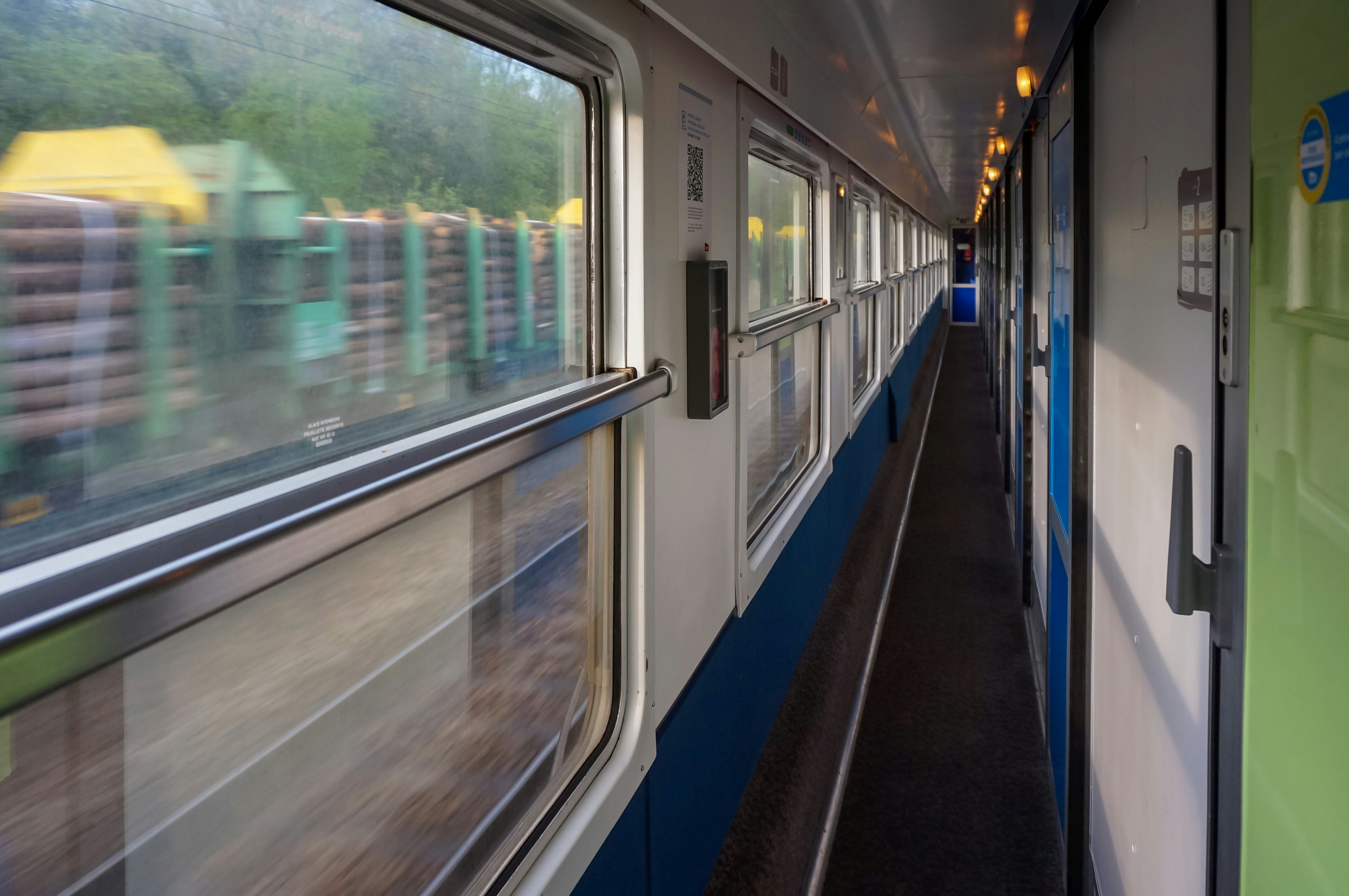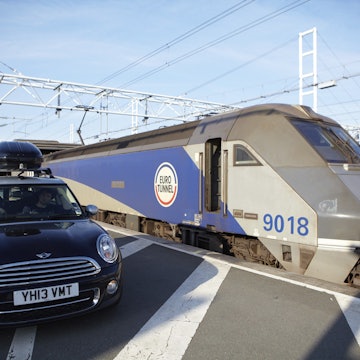
London to Barcelona: Why you should skip the high-speed service in favor of a night train via Paris

Oct 6, 2023 • 8 min read

The yellow train of Cerdagne, connecting Villefranche with Latour-de-Carol © Getty Images
A multi-stop itinerary from London to Barcelona – via Paris and the Pyrenees – is a train lover’s dream.
High in the Pyrenees on a sunny, silent morning, I had the rare feeling of leaving the modern world completely behind for a few moments.
I was standing at an international border blocked to road traffic by a jumble of rocks and debris. It was strange to find such an off-course place on this journey – I had been traveling in a nearly straight line between three of Europe’s great cities – but good fortune and a search for adventure had brought me to this strange and deserted frontier post.

Anyone who knows the history of travel between France and Spain might think I had arrived at Canfranc, the vast white elephant of a border station hidden away in the mountains that separate these countries. (The station fell asleep for decades before its recent reincarnation as a high-end hotel.) In fact, I was 200km (125 miles) further east, a short stroll from the international station of Latour-de-Carol–Enveitg (named for the two settlements nearest to it).
Gray-green mountains stretched steeply upwards all around me, with rolling farmland below. Stepping through the makeshift barricade (an apparent remnant from COVID-era restrictions, overlooked for removal), I took a few steps into Spain – then crossed back again, taking in for a moment the arbitrary nature of a land frontier. Then it was time to return to the station in time for my onward connection.

London to Paris is easy enough; onward from there, many of Europe’s great cities can be reached quickly and easily. Between France and Spain, most people take the high-speed TGV, passing through Nîmes, Montpellier and into Catalonia, reaching Barcelona via Girona and Figueres. Great journeys are rarely about speed, however, and the alternative is not only tempting for its obscurity but also for its excellent value. So after making the familiar journey from London’s St Pancras International to the Gare du Nord in Paris, rather than take the RER suburban train to the Gare de Lyon, I opted instead for a late-afternoon crosstown walk to the grand façade of Austerlitz station.
Despite being in the process of a lengthy renovation, there’s a lot to love about this terminus. Its lack of high-speed services made it feel much quieter and calmer than other stations in Paris, and it’s a short walk from the delights of the Fifth Arrondissement, including the Jardin des Plantes, Paris Mosque and the bars and restaurants around Jussieu metro station. Here, you’ll find many places for a nightcap before the evening departure south.

An overnight treat for travelers
As with many sleeper trains across Europe, French Intercités de Nuit services are enjoying a revival as travelers, rail companies and governments embrace the convenience, environmental benefits and sheer fun of snoozing your way to your destination. Previously canceled routes such as Paris to Nice are being reinstated, with plans for more on the way. The route I was traveling, from Paris to Latour-de-Carol, is one of only two French routes that never went away, stretching to the high-altitude edge of the country and providing a vital connection to the capital for far-flung French citizens.
This train was, it turns out, a treat for travelers. Pulling out on time, we ran at a leisurely overnight pace to Toulouse, France’s fifth-largest city and gateway to the far south. As dawn broke, we traveled up the valley of the Ariège River, with the scenery getting more spectacular as the Pyrenees emerged in their full glory. At a couple of the stops on the final, most scenic section of the line, the train dawdled in the morning sun, allowing passengers a leg stretch and a taste of the elevated air. Stations like Mérens-les-Vals and Andorre-L’Hospitalet felt high, remote and wild, with the early-hour lack of people contributing to the sense of wonder.

High in the Pyrenees, a fascinating station
We arrived at Latour-de-Carol without fanfare. Indeed, there weren’t many other passengers along for the ride on as pleasant a final stretch of railway line as I could remember. I counted a mere 13 other passengers quietly getting off here, unhurried, all with some time to kill before the connection to Barcelona. Perfectly placed to take advantage of the need for somewhere to pass the time (and the possibly greater need for coffee, given the absence of even a hot drink service on the train) was the Bistrot de la Gare, directly opposite the station. The friendly staff roused themselves into life as their morning’s customers approached them, a basket of just-in-time baguettes delivered just ahead of the procession of suitcases and backpacks coming toward the front door. Caffeine was certainly welcome, and fueled a proper exploration of our surroundings for the remaining 90 or so minutes.
The station was as beautifully situated as others along the line, but far larger – it even features the longest covered platform in Europe. Tracks run off in three directions. As well as the north-south French route I’d been on, the scenic Petit Train Jaune (Little Yellow Train) heads off eastward toward Perpignan, following a mountainous route through tunnels and over a dramatic suspension bridge, and stopping France’s highest station, Bolquère Eyne (1592m / 5223ft). Across the tracks, another platform hosts the Rodalies (Catalonian railways) service that would shortly take me on to Barcelona.
Almost uniquely, these three trains operate on three different track gauges. Not that there were too many other people investigating on the day I visited: judging by the bemused questioning I received from a member of the station crew as I explored the platforms, it seemed I was the only person sufficiently rail-fixated to appreciate the uniqueness of this rail junction.

Beyond the station, the historical context of the area became clearer. Two different memorials to soldiers and their families who had fled into France at the end of the Spanish Civil War vividly showed how this route, however sleepy it felt now, had once been a critical corridor. And then there was that border: an unforgettably quiet, beautiful and eerie leg stretch along a silent country lane.
In the meantime, a lonely-looking Rodalies train had rolled in and was idling – not exactly ready for the off but able-looking enough. If this unassuming train looked like a suburban service from Barcelona that had got lost and ended up in the wrong country, that’s because that’s pretty much what it was. A few minutes before boarding, I followed the platform sign labeled “Espagna,” boarded the largely empty train and sat there looking at blank information screens, pondering the possibility that I might have gotten this all wrong.
Onward to Barcelona
At the allotted hour, however, the train growled to life, the doors beeped to a close and we rumbled off. Very slowly. A few minutes later, we were in Spain at the frontier town of Puigcerda, and continued to potter downhill through a succession of seemingly silent Catalan villages, shutters on stone buildings closed hard, with only the occasional hiker or student hopping on board.
This is a line that can be enjoyed in several stages. The fortified town of Ribes de Freser is the jumping-off point for the Vall de Núria rack railway, opening up hiking in the summer and skiing in the winter. There’s a 1200-year-old monastery and hiking trails galore at Ripoll, from where more frequent trains leave for Barcelona than the three-daily Latour-de-Carol–Enveitg service.

Over three and a half hours, this train rattled southeast – and the signs of the Barcelona suburbs began to emerge. Slowly, the train began to fill up with obviously city-bound commuters; instead of forests and hills, signs of industry and motorways emerged. Finally, our once almost melancholically quiet route joined up with other lines to pass underground through the heart of Barcelona. This epic terminated at L’Hospitalet de Llobregat, a few stops southwest beyond the streets of the city’s Barri Gòtic and El Raval neighborhoods.
I disembarked at Sants station, Barcelona’s main terminus. Vast and modern with underground tracks, it lacked the sense of occasion of a historic station like crosstown Estació de França, yet shared the energetic excitement of arrival in any truly great metropolis. It was the end of the road for me after 1300km (808 miles) – but it need not have been. From here, fast trains head out across Spain to continue the adventure. The ferry terminals for the Balearic Islands of Ibiza, Mallorca and Menorca are also a short metro ride away.
I found a street-side table in the lively Collblanc neighborhood, overlooking both the city and some of the tracks I’d just traveled on, and sat still for a few minutes. It was one final, gloriously slow moment on a journey filled with them.

How to make it happen
London to Latour-de-Carol can be booked by a combination of Eurostar, SNCF and Trainline. The Paris–to–Latour-de-Carol sleeper has seats (from €22), six-berth couchette compartments (from €44) and four-berth sleeper rooms (from €68). Solo passengers will share unless they book the entire cabin using the “espace privatif” button. Tickets generally go on sale 90 days before departure.
The Latour-de-Carol–to–Barcelona train (€12) cannot be booked online. A conductor passes through the train, issuing tickets. Note that these tickets cannot be used to exit stations in Barcelona via the ticket machines, so you will need to locate a staff member and show them your ticket.
For food, by far the best option is to stock up in Paris with any provisions you might need for the night train. Unless you’ve pre-ordered, there’s no way to buy drinks, snacks or breakfast until the end of the journey.















